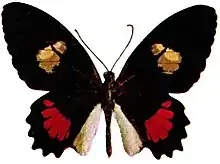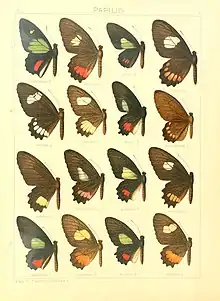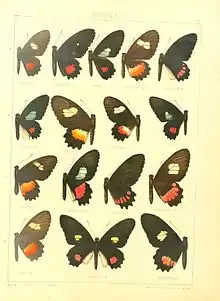Parides panares
Parides panares, the wedge-spotted cattleheart,[1] is a species of butterfly in the family Papilionidae native to the Americas. The larvae feed on Aristolochia maxima and A. pilosa.[2]
| Wedge-spotted cattleheart | |
|---|---|
 | |
| Scientific classification | |
| Domain: | Eukaryota |
| Kingdom: | Animalia |
| Phylum: | Arthropoda |
| Class: | Insecta |
| Order: | Lepidoptera |
| Family: | Papilionidae |
| Genus: | Parides |
| Species: | P. panares |
| Binomial name | |
| Parides panares (Gray, [1853]) | |
| Synonyms | |
| |
Subspecies
- P. p. panares (Gray, [1853]) (southeastern Mexico)[2]
- P. p. erythrus (Rothchild & Jordan, 1906) (Panama to Colombia)[2]
- P. p. lycimenes (Boisduval, 1836) (southeastern Mexico to Panama)[2][3]
- P. p. paralius (Rothchild & Jordan, 1906) (Ecuador)[2]
- P. p. rachelii K. S. Brown, 1994 (northern Venezuela)[2]
- P. p. tachira T. Racheli, 1991 (southwestern Venezuela)[2]
Description from Seitz
[panares panares = iphidamas in Seitz (misident.) Mexico] P. lycimenes. Male : somewhat smaller than P. vertumnus, the red area of the hindwing less triangular and its last spot smaller. Female: forewing slightly transparent at the apex; the spots somewhat yellowish, not pure white, the cell-spot usually large and extended across the cell; band of the hindwing less bright red than in P. vertumnus. Tibiae of the male not thickened. Guatemala to Ecuador, in several subspecies. — lycimenes Boisd. is the Central American form. Forewing with a large green spot, which almost always encloses at least one white spot; often a spot in the cell; hindwing with 4—6 red spots. In the female the yellowish white spot before the 1.median much larger than the preceding one; band of the hindwing broad, almost always a uniform bright red. Guatemala to Panama; also on the small islands on the west coast of the Republic of Panama. — erythrus R. & J. (3d), male : the green spot broader than in the preceding form, reaching to the hindmargin of the wing. Female: the spot before the 1.median of the forewing larger than in the preceding form; the band of the hindwing paler. Central and East Colombia and North Venezuela. — paralius R. & .J. (4a). Small, male : forewing with round yellow-white spot before the 2. median; band of the hindwing short and narrow. Female: spot on the forewing purer white than in the previous subspecies, the cell-spot reduced; the spot before the 2. median the largest; band of the hindwing almost straight. West Ecuador.[4]
 Seitz Plate 3
Seitz Plate 3 Seitz Plate 4
Seitz Plate 4
Description from Rothschild and Jordan(1906)
A full description is provided by Rothschild, W. and Jordan, K. (1906)[5] See note on synonymy under Seitz (above).
References
- Warren, A. D.; et al. (2010). "Parides panares". Butterflies of America. Retrieved 21 January 2011.
- Savela, Markku. "Parides panares". funet.fi. Retrieved 21 January 2011.
- Lewis, H. L., 1974 Butterflies of the World ISBN 0-245-52097-X Page 26, figure 13
-
Jordan, K. , in Seitz, A. ( 1907) . The Macrolepidoptera of the World. 5: The Macrolepidoptera of the American faunistic region. Papilionidae 1-45.
 This article incorporates text from this source, which is in the public domain.
This article incorporates text from this source, which is in the public domain. - Rothschild, W. and Jordan, K. (1906). A revision of the American Papilios. Novitates Zoologicae 13: 411-752. (Facsimile edition ed. P.H. Arnaud, 1967) and online
- Edwin Möhn, 2007 Butterflies of the World, Part 26: Papilionidae XIII. Parides Verlag Goecke & Evers Verlag Goecke & Evers ISBN 9783937783277
Further reading
- Lamas, Gerardo (2004). Atlas of Neotropical Lepidoptera; Checklist: Part4A Hesperioidea–Papilionoidea. Gainesville, Florida: Scientific Publishers, Inc. p. 93. ISBN 0-945417-28-4.